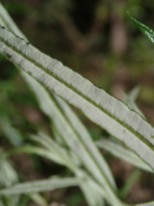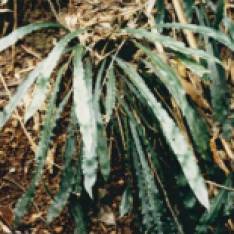One of the trickiest groups of Ferns to identify locally are a group of Ground ferns in the Genus Hypolepis. There are three different species recorded in the park but I have only ever found two of them which are Hypolepis glandulifera (Downy Ground-fern) and Hypolepis rugulosa (Ruddy Ground-fern). Without looking carefully these ferns can be mistaken for Bracken because they have a similar growth habit with fronds popping up from a spreading underground rhizome.
Hypolepis rugulosa (Ruddy Ground-fern) seems to be more common locally at higher altitudes in the Park (e.g. Wet Forest areas around Balook). It seems to like disturbed areas at the sides of roads and tracks. Its main feature for identification in the field is the reddy-brown colour of the frond stems (Stipes).
Hypolepis glandulifera (Downy Ground-fern) I have found mostly at lower altitudes, especially along waterways (e.g. Tarra River and Macks Creek). Its frond stems (Stipes) are usually a pale green colour. It usually has lots of fine hairs along the stems and the new fronds are often sticky to the touch as a result of the small glands on the tips of many of the hairs. If you have a hand lens or use a digital camera with a macro setting you can see that there is a little triangular tooth close to the sori on the underside of fertile fronds. This fern was formerly known as Hypolepis punctata.
Hypolepis muelleri (Harsh Ground-fern) is also listed in Park’s flora records for the but I have yet to find any. It can be identified by the presence of tiny hairs growing in the Sori on the underside of the fertile fronds.
















































































































































